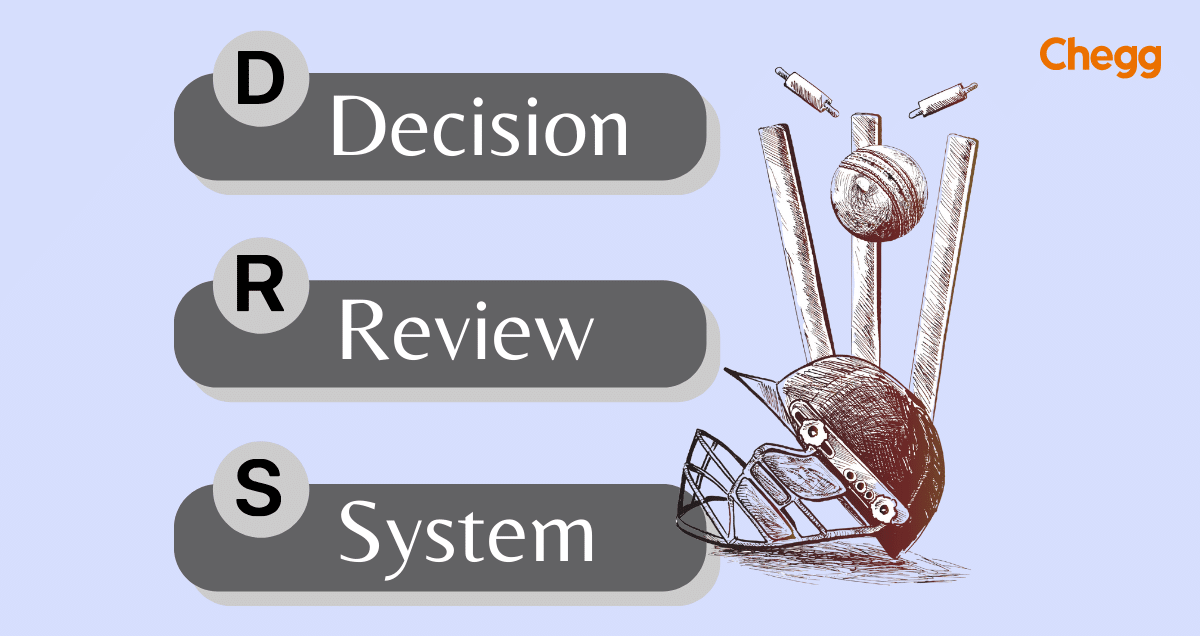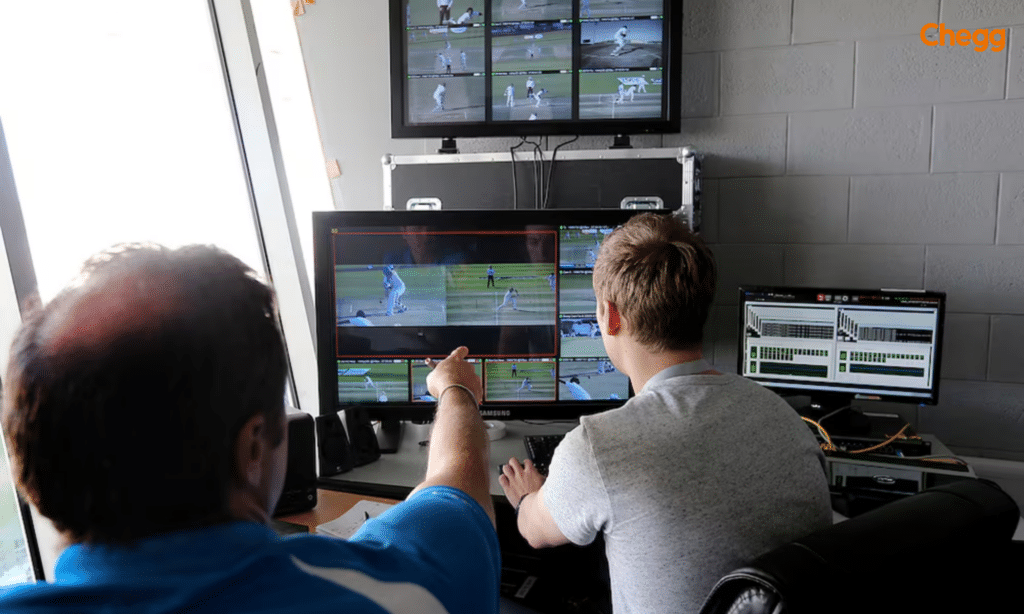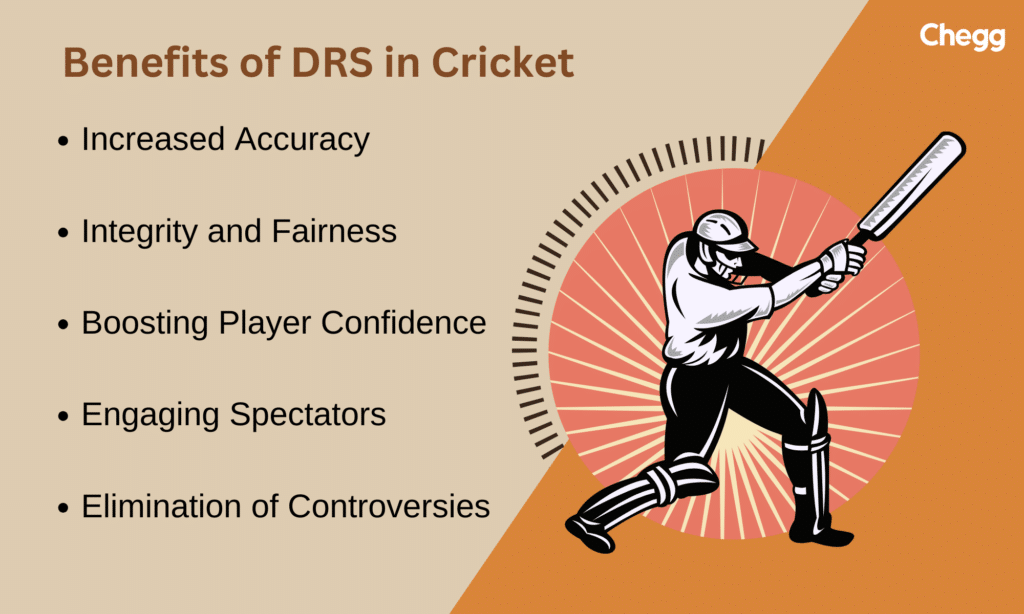Home » Full Forms » DRS Full Form: The Technological Advancement in Cricket
DRS Full Form: The Technological Advancement in Cricket

Table of Contents
What is DRS Full Form?
The DRS full form is the Decision Review System. This technological advancement has revolutionized the game of cricket. DRS has made its mark in cricket by bringing transparency, fairness, and accuracy. The main aim behind the decision review system was to eliminate any incorrect decision-making and maintain the integrity of the sport. It has significantly contributed to the game in the past few years. Read on to learn more about the history, challenges, and benefits of the technological phenomenon – Decision Review System.
History of DRS
In 2008, the International Cricket Council (ICC) needed to streamline and safeguard the game’s authenticity. After a few incidents where human error resulted in unfair play, it was decided to take the help of technology.
In January 2008, the chief executive of Cricket Australia, James Sutherland, during a test match between India and Australia, said, ‘ There have been some advances in technology that cricket can continue to explore.’ The match witnessed a series of glaring errors from umpires, causing an uproar among fans and players. Following this, Sutherland proposed the idea of player referrals. ICC approved the trial period of the review system by March. Sri Lanka and India agreed to try the new method to maintain fair play. Cut to 2008, SSC Colombo, the Decision Review System was implemented.
The main concept behind DRS in cricket was to eliminate human error and ensure that the players’ skills were put to justice. This technology comprises several essential components like the ball-tracking trajectory for leg before wicket analysis, high-resolution cameras, and audio sensors for detecting faint sounds. Since its implementation, DRS has been utilized in many international matches, T20Is, Twenty20 internationals, test matches, and one-day internationals (ODIs).
Rules and Components of DRS in Cricket
DRS full form is the Decision Review System in Cricket. It is a technological tool used to aid umpires in making more accurate decisions during matches. The system allows players to challenge on-field decisions by requesting reviews for contentious calls.
The Decision review system has a few rules that the players and the umpire must comply with. To better understand DRS, let’s look at the DRS rules in Cricket.

DRS Rules
- When the on-field umpire announces his decision, the team has a mere 15 seconds to decide whether they want to use DRS or not. If yes, then a ‘T’ must be signaled to the umpire.
- The DRS can detect decisions like LBW (Leg Before Wicket), no ball, wide, and catches.
- The number of DRS available for a team is based upon the count of unsuccessful DRS attempts by the team.
- The ball-tracking technology or Hawk-Eye is used for predicting the ball’s path and its impact on the stumps in case of leg-before-wicket decisions.
- UltraEdge is a part of DRS that uses audio sensors to detect any sounds made by the ball, such as faint edges or bat-pad contact.
- While making LBW decisions using DRS, there are three critical factors to consider – pitching, hitting, and impact.
- In the Decision Review System (DRS), factors favoring the on-field call are indicated with green marks, while factors going against it are shown as red marks. A minimum of three red marks is required to overturn the on-field umpire’s decision.
DRS Components
The Decision Review System is composed of various key components:
- Ball Tracking Technology: This part tracks the ball’s trajectory from the bowler’s hand to the point where it hits the batsman by using several cameras. It assists in determining the ball’s trajectory, swing, and spin, which helps with decisions about leg-before-wicket (LBW) and caught-behind dismissals.
- Hot Spot: Using infrared cameras, Hot Spot technology measures temperature changes on the pad or bat. This is especially useful for determining edges and how the ball affects the batsman’s body or gear.
- Snickometer: The Snickometer also called Ultra Edge uses sound sensors to pick up microscopic noises produced when the ball makes contact with the bat or pad. It’s especially helpful for picking out small edges.
- Hawk-eye: A ball-tracking device called Hawk-eye predicts its trajectory and possible impact on the stumps. It offers a visual depiction of the ball’s path and aids in LBW decisions.
- Umpire’s Call: The most important aspect of DRS is the umpire’s call. When technology indicates that the decision is within a certain margin of error, it allows the on-field umpire’s decisions in to stand.
Benefits of DRS in Cricket
DRS has made a significant impact on the rulings in cricket. Listed below are a few benefits that justify DRS meaning in cricket.

Increased Accuracy
One of the main aims behind the DRS technology was to inculcate accuracy and transparency in the game. Being infused with high technology, DRS leads to accuracy in cricket by ruling out the right decision. It does not leave room for incorrect decisions and, thus, leads to a fair game.
Integrity and Fairness
Maintaining the integrity and fairness of this esteemed sport is highly crucial. With DRS technology, players can ask for a review if they feel misjudged. It not only leads to a wise decision but also keeps the integrity intact.
Boosting Player Confidence
When the players feel they can review and have a say in the decision-making process, it boosts their confidence. There is a sense of trust in the system when people know they can challenge decisions they believe are incorrect.
Engaging Spectators
The Decision review system adds a sense of excitement to the game. It keeps the fans and even players on edge during delicate moments. The anticipation of the ruling is a real nail-biter situation.
Elimination of Controversies
The implementation of the DRS resulted in increasing controversies and unfair play. However, now with its implementation, correct and fair decisions are made, leading to eliminating controversies.
Challenges of the DRS
Listed below are a few challenges of the Decision Review System
Expensive
Implementing DRS technology like ball-tracking systems, high-resolution cameras, and specialized software in the cricket field might come off as expensive. This technological advancement requires costly equipment that can challenge smaller nations.
Training and Experience
Since the umpire still makes the final decision, there is a grave need for more trained and experienced umpires regarding DRS. This is because even though the system is high-tech, there may still be a chance of human error if the umpire is not well-versed in the technology.
Technical Difficulties
There have been a few incidents where the technology was not completely accurate, thus, leading to inaccurate decisions. Various factors, like the condition of the pitch and the ball, can influence the accuracy of ball-tracking technology. Additionally, the real-time Snickometer can sometimes be inconclusive due to background noise, affecting its reliability in detecting faint edges.
Disruption and Delays
The review process by decision review system can sometimes lead to delays disrupting the game. This further breaks the momentum and rhythm of the players.
Future of DRS in Cricket
The DRS appears to have a bright future. The DRS will remain an essential tool for preserving the integrity of cricket as more and more cricket-playing nations adopt the technology. Furthermore, we should anticipate more transparency and more precise decisions as technology advances.
Moreover, the DRS will probably be used for more than just cricket. Similar technologies have already been embraced by other sports, like football and tennis, and it will not be long before other sports do the same.
Conclusion
The DRS meaning in cricket can be justified by its numerous contributions. From maintaining the game’s integrity to bringing in transparency, there is no denying the fact that the decision review system has indeed been a game changer for cricket. The advanced technology not only boosted the players’ confidence but also kept the spectators on the edge of their seats.
While it has its challenges, the technology of DRS still has a long way to go and revolutionize how the game is played. It stands tall as a beacon of progress, reshaping the landscape of the beloved sport – Cricket.
Learn more about some other full forms:
| UEFA Full Form | ODI Full Form |
| IPL Full Form | ICC Full Form |
| FICCI Full Form | LBW Full Form |
| BCCI Full Form | BBL Full Form |
| WWE Full Form | FIFA Full Form |
DRS Full Form: FAQ’s
DRS full form is Decision Review System.
The significance of DRS in the game of cricket can be depicted by its ability to bring transparency, accuracy, and fairness to the sport. It encourages players to challenge on-field decisions and reduce manual errors.
Initially, the players were only allowed to review a dismissal per an on-field decision. Now, however, this technology can be used to review wide calls and no-balls.
The DRS works with the assistance of state-of-the-art technology. This technology helps umpires in making the right decision. By employing slow-motion TV replays, the players and umpire can review the game.
Yes, DRS can be used for no-ball.
Got a question on this topic?